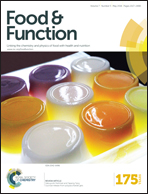Proteomic analysis of ginsenoside Re attenuates hydrogen peroxide-induced oxidative stress in human umbilical vein endothelial cells
Abstract
Ginsenoside Re is an active component in ginseng that has attracted much attention because of its evident therapeutic effects on the cardiovascular system. However, little basic information is available on the mechanisms and pharmacological effects of ginsenoside Re. The potential mechanisms and protective effects of Re on H2O2-induced oxidative injury in human umbilical vein endothelial cells (HUVECs) were investigated in this study. An oxidative injury model was established using H2O2. The anti-oxidative effects of Re were determined using a series of experiments, such as MTT and anti-oxidative indicator assays. The potential protective mechanisms of Re were explored at the proteomic level, and differentially expressed proteins were validated by quantitative real-time polymerase chain reaction and western blotting. Results indicated that Re could be a potential anti-oxidant to protect HUVECs against oxidative stress damage. Proteomic analysis showed that the expression of 23 protein spots was upregulated in Re and H2O2 groups to resist oxidative stress, 15 of which were identified by their mass spectrum. These upregulated proteins were involved in stress response, anti-oxidative systems, protein synthesis, regulation of transcription and post-translational modifications, and repair of mitochondrial functions. This study may provide new insights into the mechanisms of ginsenoside Re in protecting the cardiovascular system.


 Please wait while we load your content...
Please wait while we load your content...